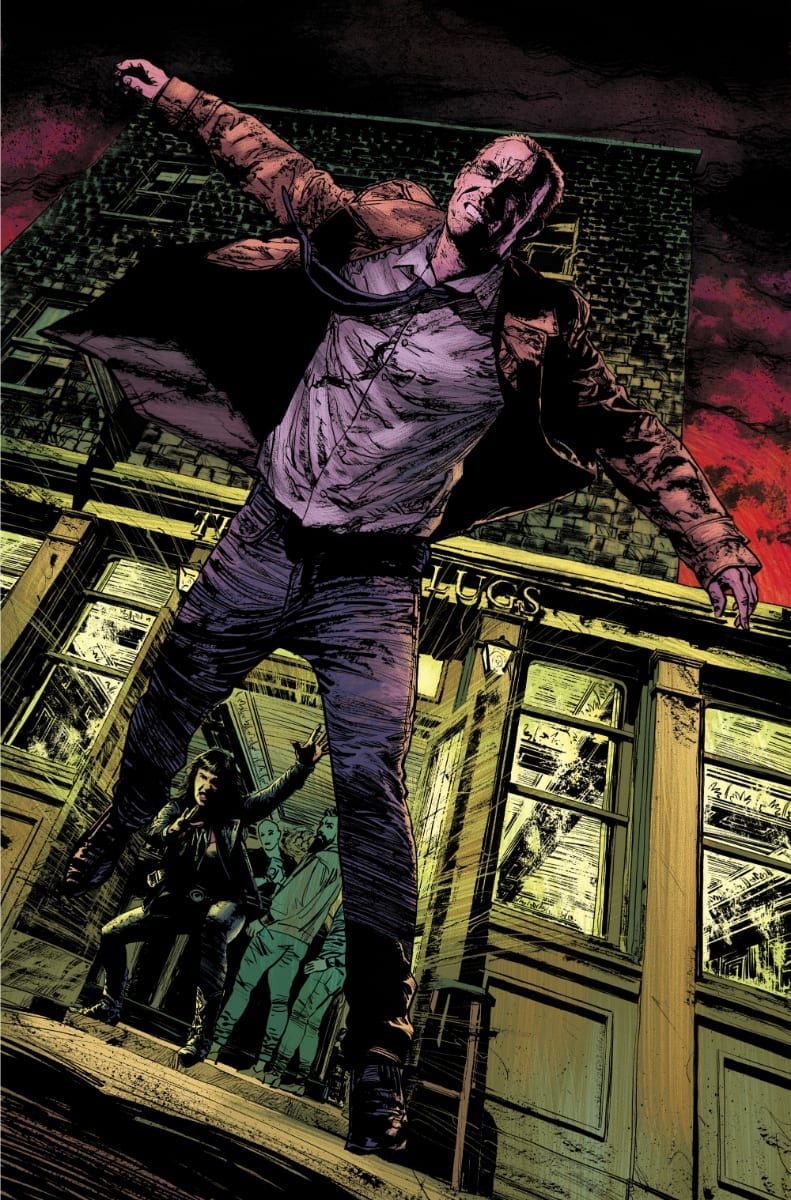Hot on the heels of last months special, DC Comics and the Sandman Universe return to the seedy world of John Constantine in a brand new ongoing series of Hellblazer. Simon Spurrier returns for writing duties with a new artistic team all ready to impress.
Newly arrived in the present, John Constantine has to find a place for himself in this world while the forces of the occult have their own ideas on the role that he will play. The more things change, the more things stay the same.

Casting A Spell
In last months Hellblazer Special, Simon Spurrier reintroduced John Constantine to the DC Universe, setting up this new ongoing series. Spurrier took the opportunity to remind readers about the long and complicated past of the modern day wizard and how it all fits in with this relaunch. And, in short, it doesn’t. At least not in any material way. This new series is about finding a home for Constantine in the modern world, which itself is about reconciling past beliefs with modern ideologies.
The character of John is there from the very beginning. If you have read any previous Hellblazer comics you will recognise the arrogant, crude, devil may care attitude of the central character from the moment Spurrier introduces him. The writer wants this representation to be the original character, not a new version but the actual one created in the 1980’s by Alan Moore, and Spurrier has captured the essence of Constantine perfectly.
Of course, by bringing the character forward in time, unchanged, it instantly creates a conflict between the past and the present. The world has moved on but John jasn’t and a large part of this issue is about that fish-out-of-water aspect of the story. John is at odds with the modern world and Spurrier uses this narrative thread to comment on the society, politics, and modern culture.
Like all of the best Hellblazer stories, this isn’t just about the adventures of John, it is also an investigation into the complexities of life in the UK. Spurrier understands this and sets the narrative around aspects of modern life; from tower block gangs to disappearing teenagers.

Drawing The Magic
John Constantine: Hellblazer #1 is also a successful horror story. Modern sensibilities are challenged within the story and, more impressively, within the artwork. Aaron Campbell is a natural when it comes to illustrating disturbing images and the pages are filled with repugnant yet realistic scenes set to haunt your dreams.
Campbell builds up the images with layer upon layer of thin, rough pencil lines. This creates a sense of depth to the panels and adds the illusion of movement. This style differentiates Hellblazer from other DC titles, distancing itself from the usual Superhero stories on offer. It is also a clearer reflection of the substance of the story, with this comic having an Age 17 rating. The language and concepts involved are not straightforward and play in the grey area of moral understanding. Campbell’s artwork is an extension of this; it is not clear cut, not clean and easy to follow.
There is a dark, overpowering atmosphere throughout this comic that, like Constantine’s predicament, is uncomfortable and unnerving. This is mainly provided by the coloring by Jordie Bellaire. She blends the colors into the dark shadows in almost every panel, giving the entire piece an ominous feel. Even when the page features a lot of light, there is still the encroaching darkness.
Bellaire also assigns color schemes to certain aspects of the comic. Different scenes, different places, and even specific actions have their own hue. This allows for an easy reading experience but also builds sight recognition for some elements of the story. When the reader reaches a scying sequence or a ghostly apparition, it is instantly recognisable as such.
The page layout has a hand-drawn appearance, with the panel borders creating inconsistent gutters on the page. This is picked up by Aditya Bidikar for his lettering by giving the speech balloons the appearance of also being hand-drawn. Coupled with the changing font size within the balloons, the lettering adds to the comic’s sense of personality and individualism.
Watch out for the switching between upper and lower case type within the speech. This tends to illustrate the different speech patterns of the characters and highlight when characters are talking to themselves. It is another example of this comic going that extra step to create something different to what a mainstream audience may be used to.

Conclusion
Constantine has never really fit into the main DC Universe. The character is difficult to get on with, a true anti-hero who often thinks of himself before others. More often than not, Hellblazer comics require the reader to exert effort to understand the deeper meanings within the stories. And, above all else, Hellblazer comics are a dark reflection of the time they are written.
With all of this in mind, the latest Sandman Universe release ticks all the relevant boxes. Simon Spurrier clearly has an understanding of the character and the world in which Constantine exists. The rest of the creative team have produced something above and beyond a typical monthly comic from one of the big two publishers. The Vertigo brand lives on within these pages.
If you are easily offended or don’t have a stomach for horror, then there will be very little on offer within the pages of Hellblazer, but for everyone else this is a gem waiting to be found.

